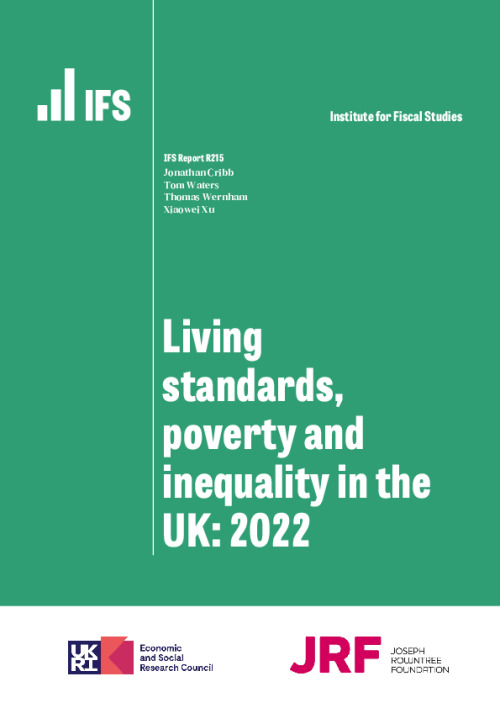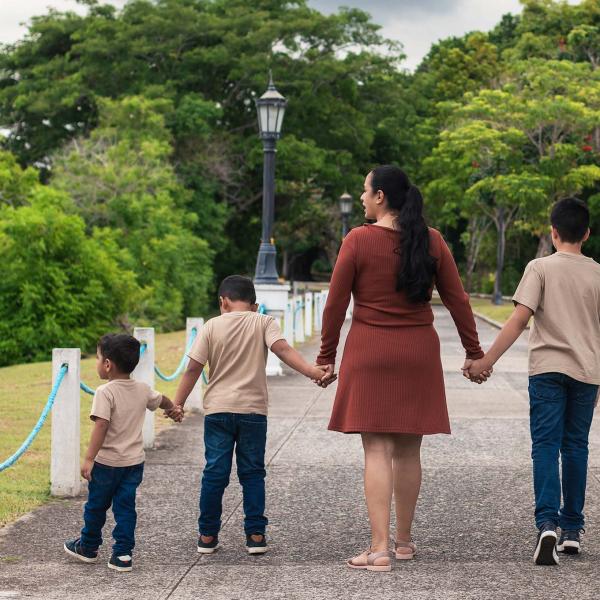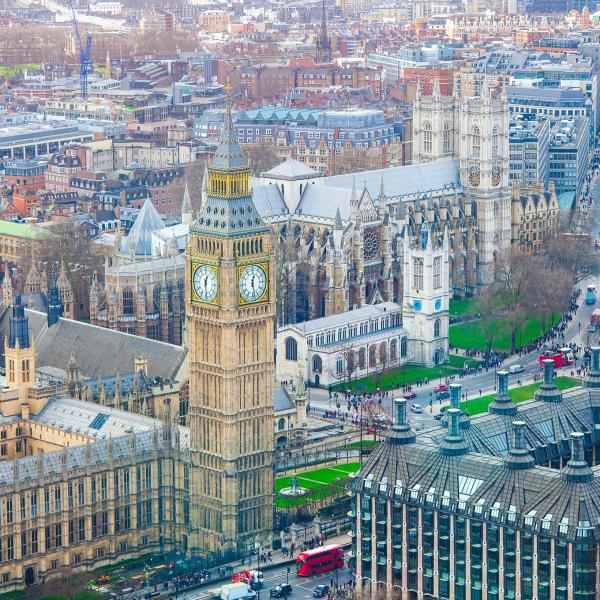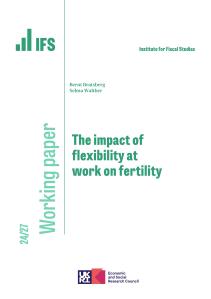This report examines how material living standards – most commonly measured by households’ incomes – have changed for different groups in the UK, and the consequences that these changes have for income inequality and for measures of deprivation and poverty. This is the 22nd annual report published by IFS authors on living standards, poverty and inequality in the UK since the annual reports started in 2001. In this report, we focus on two particular issues. First, we look at how the distribution of household income changed during the first year of the COVID-19 pandemic. Second, we use pre-pandemic data on child poverty and material deprivation to examine the situation facing poor families with children prior to the pandemic.
Key findings:
Household incomes during the pandemic
- Median (middle) disposable incomes fell by 1.7% in 2020–21 (the first year of the COVID-19 pandemic) compared with the previous year, and this is little changed if one measures income after deducting housing costs. This fall is equivalent to about one year’s post-Great-Recession income growth – a strikingly muted effect given the scale of economic disruption seen during the pandemic. In large part this is driven by the huge support provided to households in 2020–21 – particularly around £60 billion that year through the furlough scheme, and additional spending on working-age benefits of £11 billion compared with 2019–20.
- While average incomes fell, the incomes of poorer households rose in real terms, by around 3% for the lowest-income fifth of the population. This was due to the nature of the support for households, with large increases to benefits (such as the temporary uplift to universal credit), and to the fact that the poorest suffered less from falls in employment incomes which affected many on middle and higher incomes.
- The increases to benefits and tax credits in 2020–21 were substantial and – for families on low or no earnings – on average reversed the cuts to benefits that had been seen since 2011–12. In 2020–21, a working-age family with no earnings received benefits on average worth £26 per week more than in 2019–20, and the same amount as received by families without earnings in 2011–12. Most of the benefit increases were temporary, however.
- Growing incomes for people in poorer households also reduced absolute income poverty, which fell by 1 percentage point to 17% (after deducting housing costs). This fall was focused on children and pensioners, whose absolute poverty rates both fell by 2 percentage points; working-age adults without dependent children saw little change. For children, this is the largest one-year fall since UK-wide statistics were first published, in 2002–03. Low-income children and pensioners have done particularly well because pensioners were less likely to be exposed to the labour market shock of the pandemic, while families with children were more likely to gain from the increase to benefits.
- The relative poverty rate (the fraction of people with an income below 60% of the median) fell by 1.7 percentage points – more than the decline in absolute poverty, reflecting the fall in median income.
- Higher income growth for poor households pushed down measures of disposable income inequality, though the changes were not dramatic. The widely cited Gini coefficient fell from 0.35 in 2019–20 to 0.34 in 2020–21, around the same level that it has been at since the early 1990s, but still far higher than the level seen at the end of the 1970s (around 0.24).
- Despite the difficulties in collecting data and producing the official poverty statistics during the pandemic, the official statistics compare well against another source of data on income poverty, the UK Household Longitudinal Study. The two surveys show very similar changes in relative poverty rates, although – unsurprisingly – they show slightly different results for specific subgroups of the population.
- Average incomes are likely to have started to recover in 2021–22 as many people returned to work from furlough. It is more likely than not that the falls in income inequality in 2020–21 were at least partially reversed in 2021–22, with the expiry of the £20 uplift to universal credit in October, and trends in labour market earnings that suggest high earners saw larger increases in their pay.
- Looking ahead to this year (2022–23), inflation rates not seen since the early 1980s are eroding the real value of household incomes. However, with highly progressive support for households announced by the government, and tax rises (on income tax and National Insurance) which hit higher earners harder, low-income households are likely to see better income growth – or at least, smaller declines – than those on higher incomes this year. It is worth reflecting that to some extent the inflation and cost of living crisis we are now facing is a hangover from the scale of economic support provided during the pandemic, both here and internationally. This should act as a reminder that while governments can shield households temporarily, and support those most in need, they cannot protect all of us forever from the negative effects of economic shocks.
Trends in child poverty and material deprivation prior to the COVID-19 pandemic
- In 2019–20, the last year before the pandemic, 25% of children were in absolute poverty – which for a two-parent family with two young children is defined as having a weekly income below £363 after deducting housing costs. This was down from 28% in 2013–14. The fall in absolute child poverty over this six-year period (3 percentage points) was similar to the fall in poverty in the six years during and immediately after the Great Recession, and far smaller than the fall in poverty in the six years from 1997–98 (16 percentage points).
- Relative child poverty – defined as having an income of less than 60% of median income after deducting housing costs – rose in the years leading up to the pandemic. It increased from 27% in 2013–14 to 31% in 2019–20, the same level as in 2007–08. This means that low-income families with children slipped further behind those on average incomes during the recovery from the Great Recession. In 2019–20, 4.3 million children were in relative income poverty, compared with 3.7 million in 2013–14.
- The share of children in families in which at least one adult was in work rose from 82% in 2013–14 to 88% in 2019–20. Coupled with a partial recovery in earnings after the Great Recession, this led to a large increase in income from employment for low-income families with children. However, the rise in employment income was mostly offset by a fall in income from benefits, due to a series of cuts to the real value of working-age benefits. One in five children in working families had incomes below the absolute poverty line in 2019–20, the same as 17 years earlier in 2002–03.
- The absolute poverty rate for children in families with three or more children, who make up around 30% of all children, was 38% in 2019–20 – double the rate for only children and those with only one sibling (19%). Low income growth for poor larger families meant that absolute child poverty for this group was no lower in 2019–20 than it was 16 years earlier in 2003–04. Reductions in the real value of working-age benefits since 2010 were larger for families with more children, who are more reliant on benefits.
- Absolute poverty rates for black (43%) and Asian (41%) children were nearly twice as high as for white children (22%) in the years leading up to the pandemic. Absolute child poverty fell for children from all broad ethnic groups between 2013–14 and 2019–20, with black children seeing the largest fall, of 7 percentage points. However, children from all broad ethnic groups saw small rises in relative poverty over the same period, as their incomes did not keep up with those on middle incomes.
- In contrast to income measures of poverty, child material deprivation fell rapidly in the years leading up to the pandemic. The share of children who are materially deprived – defined as those in families unable to afford common items and activities – fell from 24% in 2013–14 to 18% in 2019–20. This is the largest fall seen since the measure was introduced in 2004–05, and much larger than the fall in absolute poverty.
- The ability for low-income families with children to afford many common items and activities has increased in the years running up to the pandemic. That is, for a given level of income, they seem to be less materially deprived. It is not completely clear what has driven this. One reason could be falling real prices of some essentials over that period, such as gas. There is also some evidence that some poor families may be able to support themselves slightly better through periods of low income: the fraction of families with children in the lowest fifth of household incomes who have at least £2,000 of savings, adjusting for inflation, rose from 22% in 2010 to 33% in 2013 and 38% in 2019.
- Inflation in 2022 is higher for lower-income families. The government’s package of support for energy bills is highly progressive, benefiting poorer families more than middle- or high-income families. However, the decision to offer a flat rate of support for families on means-tested benefits, rather than uprating benefits with inflation, provides less support for children in large families. While reductions in material deprivation in recent years have been partly driven by families’ increased ability to keep their homes warm enough (from 78% in 2013–14 to 88% in 2019–20), higher energy prices could mean fewer can now afford heating and other essential items, pushing up material deprivation.













